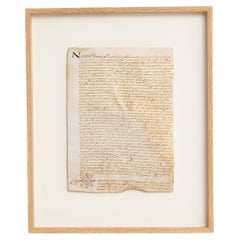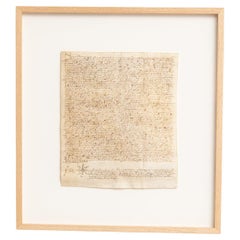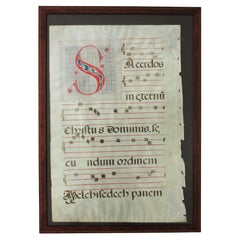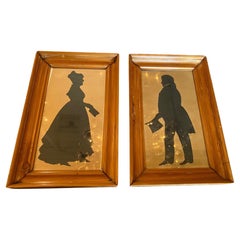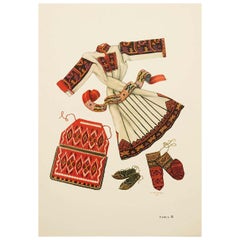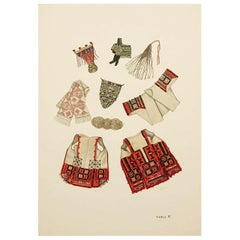Macedonian Drawings
to
2
2
2
Height
to
Width
to
2
2
2
2
66
1,125
612
507
506
2
2
2
Place of Origin: Macedonian
Enchanting Handwritten Antique Parchment: A Timeless Spanish Treasure
Located in Barcelona, Barcelona
This original antique parchment, meticulously handwritten and seemingly in Latin, is a remarkable piece originating from Spain. With its captivating aesthetics, this item exudes a pr...
Category
1930s Country Vintage Macedonian Drawings
Materials
Paper
$1,728 Sale Price
50% Off
Enchanting Handwritten Antique Parchment: A Timeless Spanish Treasure
Located in Barcelona, Barcelona
This original antique parchment, meticulously handwritten and seemingly in Latin, is a remarkable piece originating from Spain. With its captivating aesthetics, this item exudes a pr...
Category
1930s Country Vintage Macedonian Drawings
Materials
Paper
$2,086 Sale Price
50% Off
Related Items
Wall Decoration Gregorian Chant on Parchment Sheet
Located in Barcelona, ES
Large manuscript sheet with Gregorian Chant on parchment
"Sacerdos In Eternum" Gregorian Chant composition book sheet as wall decoration, Spain before XVth century...
Category
15th Century and Earlier Medieval Antique Macedonian Drawings
Materials
Parchment Paper, Wood
Wall Decoration Art Pair Silhouettes Black Framed Antique Los Angeles Gallery
Located in West Hollywood, CA
Wall Decoration Art Pair Silhouettes Black Framed Antique Los Angeles Gallery . Pair of silhouettes portrays the 19th century Lady and Gentleman With his Hat. This pair has been well taken care of and has minor wear consistent with the age. Wall art Silhouette of a Lady and a Gentleman framed in possible hand carved pine wood or fruitwood Frame.
Charming elegant profile depicts high status man at ease with himself ensured his place in hierarchy looking sharp and same goes for the Lady holding what appears to be a document. The subjects are dapperly dressed with his top hat in his hand, trimmed haircut, leather boots and the lady with a nice Hairdo and an elaborate dress. An original continental French or British silhouette in a period fruitwood light color frames and are beveled. Antique dealer Los Angeles West Hollywood La Cienega Melrose Ave. The watercolor and paper cut silhouettes...
Category
19th Century Antique Macedonian Drawings
Materials
Metal
$1,360 Sale Price
20% Off
H 13.75 in W 8.75 in D 1.5 in
1980s American School Style Interior Scene of a Sitting Room Watercolor Painting
Located in Morristown, NJ
American School (20th c.), Interior scene, watercolor on paper, signed and dated "Wisner, '81" lower right. A charming, colorful and detailed representation of a beautiful room-scape. It makes me want to grab a good book and snuggle up by the fire.
The framing is by The House of Heydenryk...
Category
1980s American Classical Vintage Macedonian Drawings
Materials
Glass, Wood, Paint, Paper
$595
H 21 in W 17.5 in D 0.5 in
French Academic Drawing of a Classical Roman
Located in Houston, TX
French academic drawing of a classical Roman. This handsome framed French drawing of a classical Roman figure was created by a talented artist ...
Category
1920s Classical Roman Vintage Macedonian Drawings
Materials
Paper
Charcoal Drawing on Blue Paper By William Wardlaw Laing, C.1880
Located in St Annes, Lancashire
Wonderful charcoal portrait of a girl.
By a very good victorian artist, William Wardlaw Laing*
Sitter unknown.
Signed lower left
Presented in an antique bleached tropical hardw...
Category
1870s Victorian Antique Macedonian Drawings
Materials
Paper, Wood
John F. Kennedy Portrait, Original Drawing Pencil on Paper Dated 1963, Signed
Located in Frankfurt am Main, DE
John F. Kennedy Portrait - original drawing in pencil and charcoal on paper, realized by Detlef Henze, hand-signed, dated December 25, 1963.
Provenance. Private collection
Charcoal...
Category
Mid-20th Century Macedonian Drawings
Materials
Paper
$876
H 15.4 in W 11.5 in D 0.5 in
Charcoal Drawing on Ingrès Paper Signed Marceau Constantin Original, F113
By Marceau Constantin
Located in Ternay, Auvergne-Rhône-Alpes
Charcoal drawing by the French artist Marceau Constantin (1918 - 2017). Drawing on ingres paper representing two characters in shades of black and grey creating a fascinating light a...
Category
1960s Mid-Century Modern Vintage Macedonian Drawings
Materials
Paper
$1,311
H 27.56 in W 19.69 in D 0.79 in
Original Drawing of The Grand Canal, Venice by Robert Hindmarsh Grundy, C.1850
Located in St Annes, Lancashire
A beautiful drawing of The Grand Canal
Fabulous quality.
On wove quality paper/card
Signed on verso.
Unframed
Free shipping
*Robert Hindmarsh Grundy...
Category
1850s Victorian Antique Macedonian Drawings
Materials
Paper
$220
H 7 in W 10 in D 0.07 in
Unknown Academy Student 19th C Drawing, Pencil on Paper, Framed, Signed
Located in Leuven , BE
Unknown academy student 19th C drawing, pencil on paper, Framed, Signed.
Category
19th Century Antique Macedonian Drawings
Materials
Paper
$715
H 29.53 in W 22.45 in D 1.97 in
1970s Spanish Impressionist Water Colour Orientalist Painting by J. Benjamín
Located in Marbella, ES
Unique 1970s Spanish impressionist water colour Orientalist painting signed J. Benjamín, with wooden frame
Interior measurements: 14 x 21cm.
Category
Late 20th Century Macedonian Drawings
Materials
Paper
$1,907
H 11.03 in W 13.39 in D 1.58 in
White Bunny Drawing by Oleg Cassini for Playboy October 1979, Signed
By Oleg Cassini
Located in Brooklyn, NY
White Bunny Drawing by Oleg Cassini for Playboy October 1979, Signed.
Illustration of a woman wearing a white body suit, choker, and hat. Signed by Oleg Cassini. Notice the body suit is in the shape of the head of a bunny with clever use of the 'whiskers'.
Approximate Measurements: Length: 11" Width: 14"
Property from the Collection of Steven Rosengard, Chicago, Illinois
This original drawing was commissioned by Playboy and included in the October 1979 issue of Playboy Magazine (pages 225-227) in a feature that included works from designers such as Bill Blass, Oleg Cassini, Edith Head, Fernando Sanchez, and Monika Tilley, among others, who create their versions of the Playboy bunny costume. Candace Collins can be seen modeling some of the designs in the feature.
Oleg Cassini is an icon of twentieth-century fashion. Though born to Russian aristocracy and raised in Italy, he built a fashion empire that was unmistakably American. Cassini is perhaps best known for the hundreds of designs he created for First Lady Jacqueline Kennedy (see images 4-8), but his achievements as a collector, connoisseur, and quintessential twentieth-century man go far beyond Camelot.
In 1913, Oleg Cassini was born in Paris to the Russian diplomat Count Alexander Loiewski and Countess Marguerite Cassini, a Russian aristocrat of Italian ancestry who also had an interesting link to America. The daughter of Count Arthur Cassini, Russian Ambassador to the United States during the McKinley and Roosevelt administrations, Marguerite dazzled turn-of-the-century Washington as her father’s official hostess and left her mark on the capital city. Stationed in Denmark when the Russian Revolution toppled the czar, Ambassador Cassini and family were exiled to Switzerland before settling in Florence, Italy, where young Oleg was raised. A true Renaissance man, he spoke Russian, French, and Danish before adding Italian and English; he studied medieval and modern European military history and costume and learned to draw; he learned horseback riding, fencing, and the art of chivalry; and, most importantly, he came to understand the struggles of the Russian titled class and other European aristocrats in the wake of the Russian Revolution and World War I.
Countess Cassini started a successful fashion business in Florence, and soon the talented young Oleg was sent to Paris to sketch the latest collections for recreation in Italy. In Rome in his early 20s, Cassini created fashions for high society women and designed for a few films, which planted the seed for his move to Hollywood. The drive to reinvent himself brought Cassini to America in the 1930s; in his autobiography he describes arriving nearly penniless in mid-Depression New York City where his title as an exiled Russian Count meant even less than in war-devastated Europe. Down and out, Cassini struggled for employment, having sketching skills but no knowledge of the wholesale trade required for survival in Manhattan’s Seventh Avenue fashion district. However, he excelled at making connections, and Cassini slowly entered New York society. He was soon joined by younger brother Igor (who had studied in America and travelled with the young Emilio Pucci) and his parents, the once-dazzling Countess and his father, the displaced diplomat still loyal to Russia. The family settled in Washington, D.C., and Igor worked his way up the Hearst newspaper chain to become the famous society columnist Cholly Knickerbocker.
In New York, Oleg Cassini married the troubled socialite Merry Fahrney (who would go on to marry eight times), but the marriage ended in scandal for Oleg, and he decided to follow his original intention and head for Hollywood. Despite initial difficulties, Cassini gained access to Hollywood’s elite (partially through his skills on the tennis court), and was soon hired as a designer at Paramount Pictures alongside the redoubtable Edith Head. In her 1941 film debut I Wanted Wings, Veronica Lake wore a memorable Cassini design. That same year, Cassini met and married the newest young Hollywood star on the scene, the beautiful 20th Century Fox–talent Gene Tierney.
With the outbreak of World War II, Cassini enlisted in the Coast Guard but was transferred to the U.S. Army Cavalry which allowed officers of foreign birth. He attended basic training at Fort Riley, Kansas, and the horsemanship he learned as a boy served him greatly. He attended Officer Candidate School and reached the rank of First Lieutenant (he also became an American citizen at this time, losing his title of Count). Cassini spent several years posted at Fort Riley, where Tierney joined him before he landed a convenient military post in Hollywood. As Tierney’s career thrived (she played the title role in Otto Preminger’s Laura in 1944), she was able to assert her influence over 20th Century Fox’s head Daryl Zanuck, who hired Cassini as designer for Tierney on her 1946 film The Razor’s Edge, which proved to be a brilliant showcase for his talents. The pair separated the same year and, again seeking reinvention, Cassini re-established himself in New York City as a fashion designer. By 1950, the Oleg Cassini label was born.
Combining his knowledge of Old World and modern Europe, Hollywood, the tennis courts of Palm Beach and Newport, and of course, New York City, Oleg Cassini invented a new brand of fashion that was distinctly American and of its moment. For his first collection, Cassini took to the stage, narrating the looks and imbuing the scene with his personality, unusual in an industry where the designers typically remained backstage and the models were called by number over a PA. The first collection was a smash — the president of Lord & Taylor devoted all of their storefront windows to his designs — and by 1955 sales had reached $5,000,000. Oleg Cassini’s career had turned a very positive corner.
Cassini spent the early 1950s traversing the country, personally selling his collections to department stores in the interior, something his predecessors had never done, and moving between the Hollywood and New York scenes. Cassini’s brother Igor coined the term “the Jet Set” for this generation that constantly flew from New York to Los Angeles (then a ten-hour flight), Las Vegas, Paris, Rome, and the Riviera. In 1954, Cassini set out to woo Grace Kelly and sent her roses every day. The two were briefly engaged before her marriage to Prince Rainier of Monaco.
In December 1960, Cassini’s career-defining opportunity came when he was chosen by Jacqueline Kennedy to design her fashions for the White House. Cassini had long known Joe Kennedy and his war-hero son John, and had first met Jacqueline Bouvier before her marriage in the early 1950s. Invited by President-Elect Kennedy to meet Jacqueline at Georgetown Hospital (she had just given birth to son John Jr.) to present to her drawings of potential dresses and First Lady looks, Cassini worked furiously to prepare a new line for the First Lady. Mrs. Kennedy had always had her clothes made by the top French couturiers of the day, but for the White House she wanted an American designer. Cassini wrote in his autobiography that he told the First Lady: “‘You have an opportunity here,’ I said, ‘for an American Versailles.’ She understood completely what I was trying to communicate; she began to talk excitedly about the need to create an entirely new atmosphere at the White House. She wanted it to become the social and intellectual capital of the nation” (Oleg Cassini, In My Own Fashion, 1987, p. 327).
Mrs. Kennedy loved Cassini’s design for a gown to wear to the Inaugural Gala (she had already ordered a dress from Bergdorf’s for the Inaugural Ball), and Cassini was selected as the First Lady’s designer and was soon dubbed the “Secretary of Style.” From 1960 to 1963, Oleg Cassini would design over 300 items for Mrs. Kennedy, creating the “Jackie Look” that contributed not only to a fashion revolution but also the dawn of a new age. Cassini wrote that “Jackie played a very active role in the selection of her clothes. She loved brilliant colors — pistachio, hot pink, yellow, and white among others. Her sense of style was very precise; she would make editorial comments on the sketches I sent her. She always knew exactly what she wanted; her taste was excellent” (Oleg Cassini, In My Own Fashion, 1987, p. 334).
After the Camelot years, Cassini’s business flourished and grew into a major industry; his name appeared on everything from couture to tennis-, sport-, and swimwear, car interiors, housewares, and perfume. He collected beautiful and rare artwork, arms and armor, and antique furniture, and lived the lifestyle projected by his image. From this period onward, Cassini also came to live in important homes. Of his Gothic Gramercy Park townhouse on Manhattan’s 19th Street he would write imaginatively, “I walked into the foyer and immediately fell in love. It was a place unlike any other in New York, a sixteenth-century Dutch house transported brick by brick from Europe by the Wells Fargo family in the early twentieth century. There was a vaulted, twenty-foot ceiling in the living room, leaded windows, elegantly carved wood paneling...
Category
Mid-20th Century Macedonian Drawings
Materials
Paper
Framed Sketch, Drawing ‘L’aumône’ 'Almsgiving' 19th French School
Located in Beuzevillette, FR
Adorable drawing from the middle of the 19th century representing an alms giving scene in a church. In the background of the drawing, there is a painting representing Saint Martin cutting off his coat to offer it to a beggar. This painting echoes the symbolism of the sketch.
7 characters appear on the drawing: a poorly dressed woman with a patched dress...
Category
19th Century Antique Macedonian Drawings
Materials
Paper, Crayon
$1,472 Sale Price
35% Off
H 5.91 in W 4.34 in D 1.19 in
Previously Available Items
The National Dresses of Macedonia Illustrated Drawing in Plate, 1963
Located in Barcelona, Barcelona
The National dresses of Macedonia illustrated by Marija Malahova and Olga Benson.
Drawing in plate, 1963.
Measures: 48.2 x 33.8 cm
In original condition, with minor wear co...
Category
1960s Country Vintage Macedonian Drawings
Materials
Paper
National Dresses of Macedonia Illustrated Drawing in Plate, 1963
Located in Barcelona, Barcelona
The National dresses of Macedonia illustrated by Marija Malahova and Olga Benson.
Drawing in plate, 1963.
Measures: 48.2 x 33.8 cm
In original condition, with minor wear co...
Category
1960s Country Vintage Macedonian Drawings
Materials
Paper
National Dresses of Macedonia Illustrated Drawing in Plate, 1963
Located in Barcelona, Barcelona
The National Dresses of Macedonia illustrated by Marija Malahova and Olga Benson.
Drawing in plate. 1963.
Measures: 48.2 x 33.8 cm
In original condition, with minor wear c...
Category
1960s Country Vintage Macedonian Drawings
Materials
Paper
National Dresses of Macedonia Illustrated Drawing in Plate, 1963
Located in Barcelona, Barcelona
The national dresses of Macedonia illustrated by Marija Malahova and Olga Benson.
Litpgraphy Drawing in plate. 1963.
Measures: 48.2 x 33.8 cm
In original condition, with mi...
Category
1960s Country Vintage Macedonian Drawings
Materials
Paper
National Dresses of Macedonia Illustrated Drawing in Plate, 1963
Located in Barcelona, Barcelona
The national dresses of Macedonia illustrated by Marija Malahova and Olga Benson.
Drawing in plate. 1963.
Measures: 48.2 x 33.8 cm
In original condition, with minor wear co...
Category
1960s Country Vintage Macedonian Drawings
Materials
Paper
National Dresses of Macedonia Illustrated Drawing in Plate, 1963
Located in Barcelona, Barcelona
The national dresses of Macedonia illustrated by Marija Malahova and Olga Benson.
Drawing in plate. 1963.
Measures: 48.2 x 33.8 cm
In original condition, with minor wear c...
Category
1960s Country Vintage Macedonian Drawings
Materials
Paper
National Dresses of Macedonia Illustrated Drawing in Plate, 1963
Located in Barcelona, Barcelona
The National Dresses of Macedonia illustrated by Marija Malahova and Olga Benson.
Drawing in plate. 1963.
Measures: 48.2 x 33.8 cm
In original condition, with minor wear c...
Category
1960s Country Vintage Macedonian Drawings
Materials
Paper
National Dresses of Macedonia Illustrated Drawing in Plate, 1963
Located in Barcelona, Barcelona
The national dresses of Macedonia illustrated by Marija Malahova and Olga Benson.
Drawing in plate. 1963.
Measures: 48.2 x 33.8 cm
In original condition, with minor wear c...
Category
1960s Country Vintage Macedonian Drawings
Materials
Paper
National Dresses of Macedonia Illustrated Drawing in Plate, 1963
Located in Barcelona, Barcelona
The national dresses of Macedonia illustrated by Marija Malahova and Olga Benson.
Drawing in plate. 1963.
Measure: 48.2 x 33.8 cm
In original condition, with minor wear co...
Category
1960s Country Vintage Macedonian Drawings
Materials
Paper
National Dresses of Macedonia Illustrated Drawing in Plate, 1963
Located in Barcelona, Barcelona
The National Dresses of Macedonia illustrated by Marija Malahova and Olga Benson.
Drawing in plate, 1963.
Measures: 48.2 x 33.8 cm
In original condition, with minor wear c...
Category
1960s Country Vintage Macedonian Drawings
Materials
Paper
National Dresses of Macedonia Illustrated Drawing in Plate, 1963
Located in Barcelona, Barcelona
The national dresses of Macedonia illustrated by Marija Malahova and Olga Benson.
Drawing in plate. 1963.
Measures: 48.2 x 33.8 cm
In original condition, with minor wear c...
Category
1960s Country Vintage Macedonian Drawings
Materials
Paper
National Dresses of Macedonia Illustrated Drawing in Plate, 1963
Located in Barcelona, Barcelona
The national dresses of Macedonia illustrated by Marija Malahova and Olga Benson.
Drawing in plate, 1963.
Measures: 48.2 x 33.8 cm
In original condition, with minor wear c...
Category
1960s Country Vintage Macedonian Drawings
Materials
Paper
Recently Viewed
View AllMore Ways To Browse
Set Of Drawers Gustavian
Sevres Pair Biscuit
Shield Fireplace Screen
Shipwreck Jar
Shiva Head
Siena Italy Plates
Silver Baby Spoon
Silver Clothes Brush
Silver Cocktail Sticks
Silver Dresser Jars
Silver Muffineer
Silver Playing Card Box
Silver Shotgun
Silver Teapots With Burner
Slate Sink
Snake Murano
Soldier Clock
Spade Diamond Club Heart
